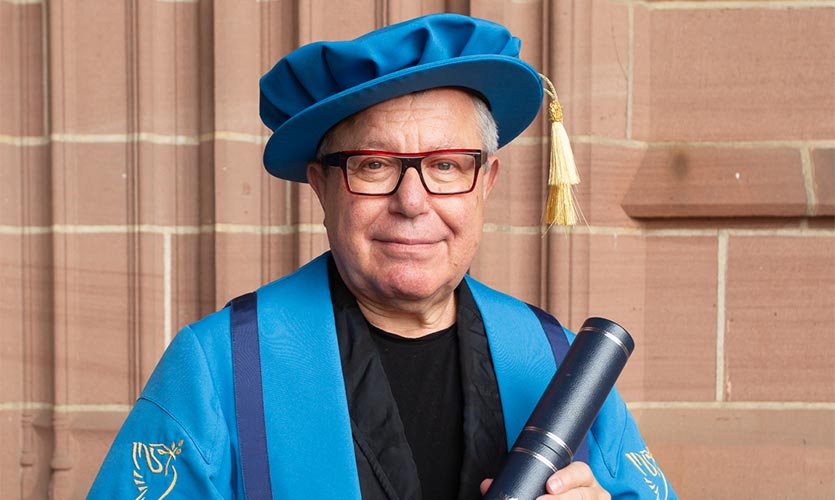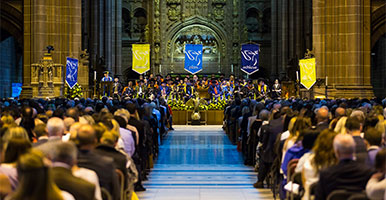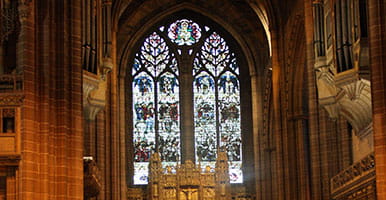Daniel Libeskind
Presented by Jonathan Falkingham

Honourable Chancellor, I have pleasure in presenting Daniel Libeskind for the award of an Honorary Fellowship for his outstanding achievements in architecture and design.
Born in Lodz, Poland, shortly after the Second World War, Daniel Libeskind has lived a remarkably international life. He immigrated with his family to Israel at the age of 11; they moved again to New York when he was thirteen. Since then he has moved over a dozen times – “there are many worlds in my head,” he has written, “and I bring all of them to the projects I work on.” His buildings and sculptures today mark the skylines and capture the history of cities as diverse as Berlin, Manchester, San Francisco, New York, Copenhagen, Milan, Dublin, Ottawa, Sao Paulo, Warsaw, Manila, and Wuhan.
Daniel Libeskind is one of the most famous architects of our age – celebrated as an architect of ‘visually dynamic buildings’ with ‘a striking angularity that seems to defy gravity.’ His work is often characterized by fragmentation and distortion, as can be seen here in the North West of England in his design for the Imperial War Museum North in Manchester.
Daniel Libeskind’s sensibility as an artist is deeply shaped by history: he was born into a post-Holocaust world to Polish-Jewish parents who were both Holocaust survivors. He brings that history to his work with its focus on trauma and memory – not the trauma of a singular catastrophe, he has written in his autobiography, “but a trauma that involved the destruction of a community and its real yet also virtual presence.”
But Daniel Libeskind didn’t set out to be an architect – he was expected to be a musician and was, in fact, something of a child prodigy, an accordion player so good that he appeared alongside the violinist Itzhak Perlman captivating reviewers with his virtuosity.
But as the limitations of a career as an accordion player grew clear, Daniel found himself spending more time drawing – although he claims never to have given up the music, “I just changed my instrument to architecture” he says. Once his family had moved to America, he took a technical drawing course at the Bronx High School of Science.
Although he has been an architect his entire adult life, he did not actually have a building built until he was fifty-two years old. He founded Studio Daniel Libeskind in 1989 with his wife, Nina, and is its principal design architect. His first commission was to build a small museum in Germany honouring Felix Nussbaum, an artist who died at Auschwitz. The building was such a success he was invited to design the Jewish Museum in Berlin – his celebrated design has ensured that the meaning of the Holocaust is integrated into the consciousness and memory of the city of Berlin.
His buildings, which often deal with difficult or painful historical events, include the Imperial War Museum North in Manchester; the Grand Canal Theatre in Dublin; the Denver Art Museum in the USA; and the National Holocaust Monument in Ottawa, Canada. He is presently constructing the CityLife masterplan in Milan, Italy, the Modern Art Museum in Lithuania, and just last month Studio Libeskind completed their first project in China – the museum of Zhang Zhidong in Wuhan.
But his most famous commission came in 2002 when he was selected to oversee the rebuilding of the World Trade Centre, which had been destroyed the previous year in the September 11 terrorist attack. He titled his concept for the site “Memory Foundations”. Crucial to the insight he brought to this mammoth task was that “buildings have hearts and souls, just as cities do.” He realised that the soul of the site where the Twin Towers once stood existed not only in its famous skyline but below in the bedrock of Manhattan. On visiting Ground Zero as a competitor for the open competition to redesign the WTC in 2002 Daniel asked to go down into the 70ft pit. It was somewhere none of the other competitors had asked to go. It was like visiting the catacombs of Rome, Daniel has written, “We felt a whole city down there. The ashes of those who died, and the hopes of those who survived. We felt we were in the presence of the sacred.”
It was there that Daniel Libeskind understood the concept of his design – a scheme that would draw up out of the New York City bedrock. In his masterplan for the site, Daniel devoted half of the 16-acres to public space, defined by the Memorial and the Memorial Museum, setting aside further locations for sustainable, high-tech office towers, reconnecting the historic street-grid, reinvigorating the streetscape and reshaping the underground transit concourses and even finding room for two major new public facilities: an iconic new transportation station and a performing arts centre.
This most considered and international of artists last visited Liverpool three years ago when he spoke spellbindingly to students at the University about his extraordinary career before being honoured with a reception at Liverpool Town Hall. We are delighted to welcome Daniel back to Liverpool today to recognise the phenomenal achievements of an artist who has journeyed across national boundaries and cultures to capture through his designs for buildings essential truths about our shared past.
Honourable Chancellor, it is therefore with great pleasure that I present Daniel Libeskind for the University’s highest honour, an Honorary Fellowship.



